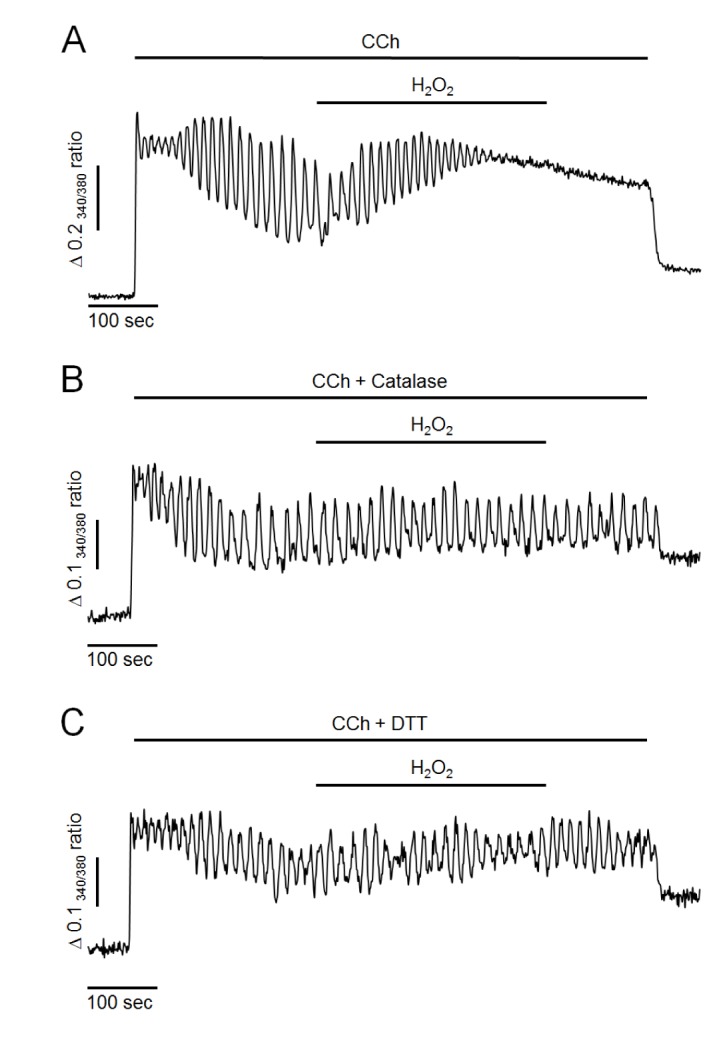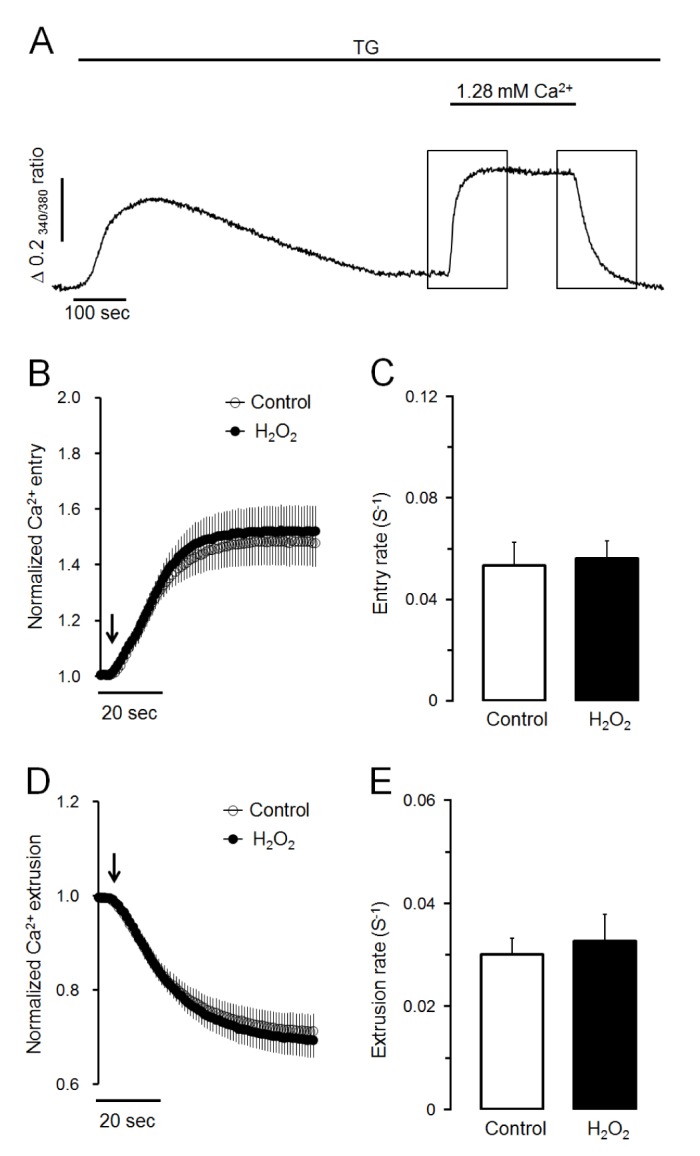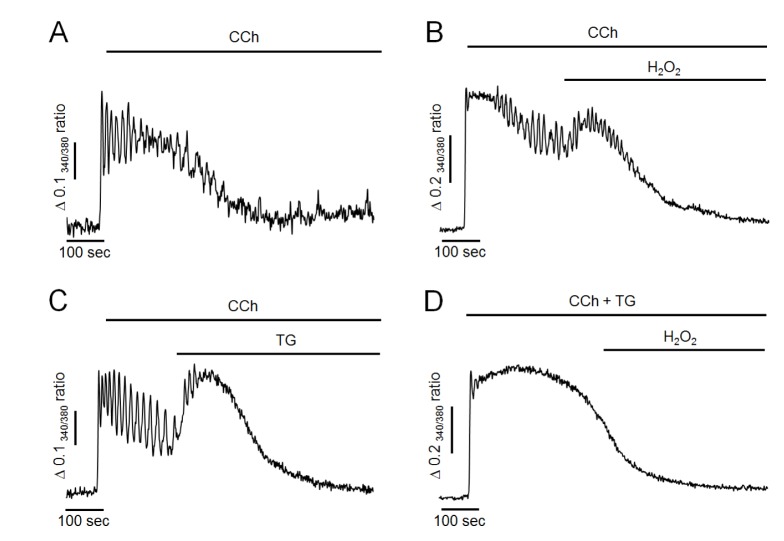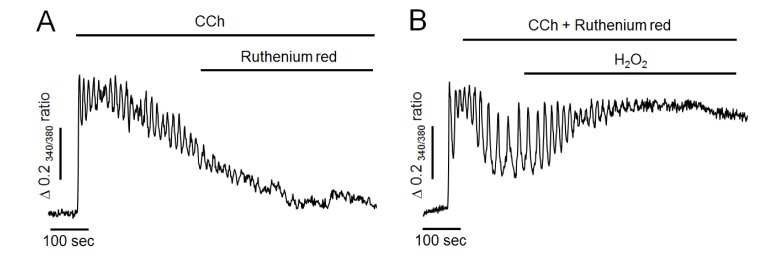1. Turrens JF. Mitochondrial formation of reactive oxygen species. J Physiol. 2003; 552:335–344. PMID:
14561818.

2. Valko M, Leibfritz D, Moncol J, Cronin MT, Mazur M, Telser J. Free radicals and antioxidants in normal physiological functions and human disease. Int J Biochem Cell Biol. 2007; 39:44–84. PMID:
16978905.

3. Gardner AM, Xu FH, Fady C, Jacoby FJ, Duffey DC, Tu Y, Lichtenstein A. Apoptotic vs. nonapoptotic cytotoxicity induced by hydrogen peroxide. Free Radic Biol Med. 1997; 22:73–83. PMID:
8958131.

4. Finkel T, Holbrook NJ. Oxidants, oxidative stress and the biology of ageing. Nature. 2000; 408:239–247. PMID:
11089981.

5. Yu BP. Cellular defenses against damage from reactive oxygen species. Physiol Rev. 1994; 74:139–162. PMID:
8295932.

6. Droge W. Free radicals in the physiological control of cell function. Physiol Rev. 2002; 82:47–95. PMID:
11773609.
7. Galan C, Jardin I, Dionisio N, Salido G, Rosado JA. Role of oxidant scavengers in the prevention of Ca2
+ homeostasis disorders. Molecules. 2010; 15:7167–7187. PMID:
20953160.
8. Mukherjee R, Criddle DN, Gukovskaya A, Pandol S, Petersen OH, Sutton R. Mitochondrial injury in pancreatitis. Cell Calcium. 2008; 44:14–23. PMID:
18207570.

9. Kiselyov K, Muallem S. ROS and intracellular ion channels. Cell Calcium. 2016; 60:108–114. PMID:
26995054.

10. Zheng Y, Shen X. H2O2 directly activates inositol 1,4,5-trisphosphate receptors in endothelial cells. Redox Rep. 2005; 10:29–36. PMID:
15829109.
11. Sato T, Kaneko YK, Sawatani T, Noguchi A, Ishikawa T. Obligatory role of early Ca
2+ responses in H
2O
2-induced β-cell apoptosis. Biol Pharm Bull. 2015; 38:1599–1605. PMID:
26424020.

12. Altinkilic S, Naziroğlu M, Uğuz AC, Ozcankaya R. Fish oil and antipsychotic drug risperidone modulate oxidative stress in PC12 cell membranes through regulation of cytosolic calcium ion release and antioxidant system. J Membr Biol. 2010; 235:211–218. PMID:
20574816.
13. Grupe M, Myers G, Penner R, Fleig A. Activation of store-operated I
CRAC by hydrogen peroxide. Cell Calcium. 2010; 48:1–9. PMID:
20646759.
14. Bari MR, Akbar S, Eweida M, Kuhn FJ, Gustafsson AJ, Luckhoff A, Islam MS. H
2O
2-induced Ca
2+ influx and its inhibition by N-(p-amylcinnamoyl) anthranilic acid in the beta-cells: involvement of TRPM2 channels. J Cell Mol Med. 2009; 13:3260–3267. PMID:
19382906.
15. Giambelluca MS, Gende OA. Hydrogen peroxide activates calcium influx in human neutrophils. Mol Cell Biochem. 2008; 309:151–156. PMID:
18008137.

16. Redondo PC, Jardin I, Hernandez-Cruz JM, Pariente JA, Salido GM, Rosado JA. Hydrogen peroxide and peroxynitrite enhance Ca
2+ mobilization and aggregation in platelets from type 2 diabetic patients. Biochem Biophys Res Commun. 2005; 333:794–802. PMID:
15963463.
17. Zaidi A, Michaelis ML. Effects of reactive oxygen species on brain synaptic plasma membrane Ca
2+-ATPase. Free Radic Biol Med. 1999; 27:810–821. PMID:
10515585.
18. Bruce JI, Elliott AC. Oxidant-impaired intracellular Ca
2+ signaling in pancreatic acinar cells: role of the plasma membrane Ca
2+-ATPase. Am J Physiol Cell Physiol. 2007; 293:C938–C950. PMID:
17494627.
19. Petersen OH. Calcium signalling and secretory epithelia. Cell Calcium. 2014; 55:282–289. PMID:
24508392.

20. Williams JA. Regulation of acinar cell function in the pancreas. Curr Opin Gastroenterol. 2010; 26:478–483. PMID:
20625287.

21. Yule DI, Straub SV, Bruce JI. Modulation of Ca
2+ oscillations by phosphorylation of Ins(1,4,5)P3 receptors. Biochem Soc Trans. 2003; 31:954–957. PMID:
14505457.
22. Giovannucci DR, Groblewski GE, Sneyd J, Yule DI. Targeted phosphorylation of inositol 1,4,5-trisphosphate receptors selectively inhibits localized Ca
2+ release and shapes oscillatory Ca
2+ signals. J Biol Chem. 2000; 275:33704–33711. PMID:
10887192.
23. Putney JW. The physiological function of store-operated calcium entry. Neurochem Res. 2011; 36:1157–1165. PMID:
21234676.

24. Gerasimenko JV, Gerasimenko OV, Petersen OH. The role of Ca
2+ in the pathophysiology of pancreatitis. J Physiol. 2014; 592:269–280. PMID:
23897234.
25. Sutton R, Criddle D, Raraty MG, Tepikin A, Neoptolemos JP, Petersen OH. Signal transduction, calcium and acute pancreatitis. Pancreatology. 2003; 3:497–505. PMID:
14673201.

26. Perez S, Pereda J, Sabater L, Sastre J. Redox signaling in acute pancreatitis. Redox Biol. 2015; 5:1–14. PMID:
25778551.
27. Ward JB, Sutton R, Jenkins SA, Petersen OH. Progressive disruption of acinar cell calcium signaling is an early feature of cerulein-induced pancreatitis in mice. Gastroenterology. 1996; 111:481–491. PMID:
8690215.

28. Criddle DN. Reactive oxygen species, Ca
2+ stores and acute pancreatitis; a step closer to therapy? Cell Calcium. 2016; 60:180–189. PMID:
27229361.
29. Park HS, Betzenhauser MJ, Zhang Y, Yule DI. Regulation of Ca
2+ release through inositol 1,4,5-trisphosphate receptors by adenine nucleotides in parotid acinar cells. Am J Physiol Gastrointest Liver Physiol. 2012; 302:G97–G104. PMID:
21960523.
30. Park HS, Betzenhauser MJ, Won JH, Chen J, Yule DI. The type 2 inositol (1,4,5)-trisphosphate (InsP
3) receptor determines the sensitivity of InsP3-induced Ca
2+ release to ATP in pancreatic acinar cells. J Biol Chem. 2008; 283:26081–26088. PMID:
18658132.
31. Zaidi A, Barŕon L, Sharov VS, Schoneich C, Michaelis EK, Michaelis ML. Oxidative inactivation of purified plasma membrane Ca
2+-ATPase by hydrogen peroxide and protection by calmodulin. Biochemistry. 2003; 42:12001–12010. PMID:
14556631.
32. Hidalgo C, Donoso P. Crosstalk between calcium and redox signaling: from molecular mechanisms to health implications. Antioxid Redox Signal. 2008; 10:1275–1312. PMID:
18377233.

33. Berridge MJ, Bootman MD, Roderick HL. Calcium signalling: dynamics, homeostasis and remodelling. Nat Rev Mol Cell Biol. 2003; 4:517–529. PMID:
12838335.

34. Viola HM, Arthur PG, Hool LC. Transient exposure to hydrogen peroxide causes an increase in mitochondria-derived superoxide as a result of sustained alteration in L-type Ca
2+ channel function in the absence of apoptosis in ventricular myocytes. Circ Res. 2007; 100:1036–1044. PMID:
17347474.
35. Redondo PC, Salido GM, Pariente JA, Rosado JA. Dual effect of hydrogen peroxide on store-mediated calcium entry in human platelets. Biochem Pharmacol. 2004; 67:1065–1076. PMID:
15006543.

36. Aarts MM, Tymianski M. TRPMs and neuronal cell death. Pflugers Arch. 2005; 451:243–249. PMID:
16044308.

37. Vats YA, Fedirko NV, Klevets MY, Voitenko NV. Role of SH groups in the functioning of Ca2+-transporting ATPases regulating Ca2+ homeostasis and exocytosis. Neurophysiology. 2002; 34:5–12.
38. Burk SE, Lytton J, MacLennan DH, Shull GE. cDNA cloning, functional expression, and mRNA tissue distribution of a third organellar Ca
2+ pump. J Biol Chem. 1989; 264:18561–18568. PMID:
2553713.
39. Xue P, Deng LH, Zhang ZD, Yang XN, Xia Q, Xiang DK, Huang L, Wan MH. Effect of Chaiqinchengqi decoction on sarco/endoplasmic reticulum Ca
2+-ATPase mRNA expression of pancreatic tissues in acute pancreatitis rats. World J Gastroenterol. 2008; 14:2343–2348. PMID:
18416460.
40. Pariente JA, Camello C, Camello PJ, Salido GM. Release of calcium from mitochondrial and nonmitochondrial intracellular stores in mouse pancreatic acinar cells by hydrogen peroxide. J Membr Biol. 2001; 179:27–35. PMID:
11155207.

41. Gonzalez A, Granados MP, Salido GM, Pariente JA. H
2O
2-induced changes in mitochondrial activity in isolated mouse pancreatic acinar cells. Mol Cell Biochem. 2005; 269:165–173. PMID:
15786729.








 PDF
PDF ePub
ePub Citation
Citation Print
Print


 XML Download
XML Download